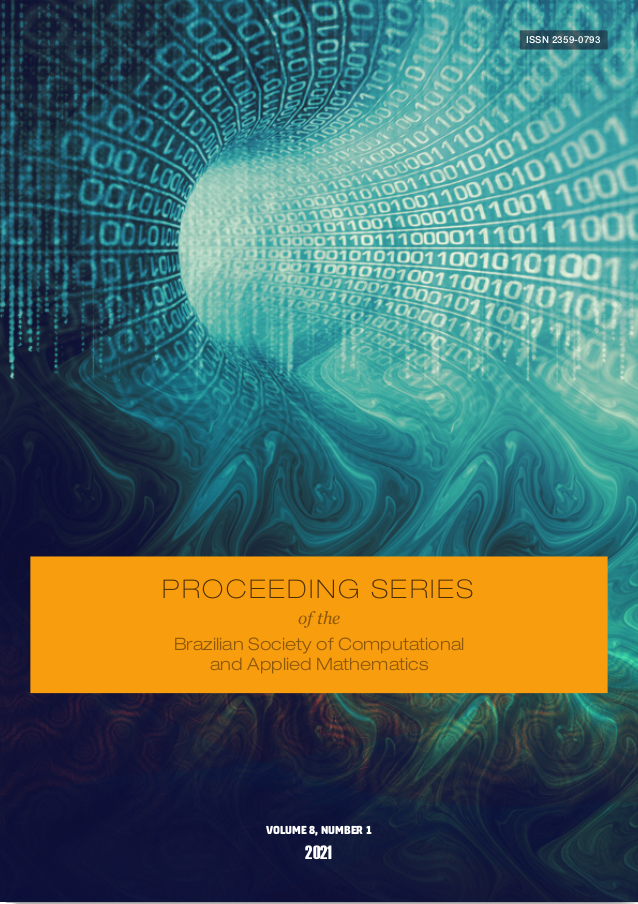Lubrication theory stucly with differentiated geometry parameterization and applications in hydrodynamic bearings
DOI:
https://doi.org/10.5540/03.2021.008.01.0430Palavras-chave:
Lubrication Theory, Geometry parameterization, Numerical Simulation, Hydrodynamic Bearings, Dynamic Coefficients.Resumo
This article use the lubrication theory to simplify the Navier-Stokes equations for the flow between two cylinders with a small thickness of oil film. An effective parameterization of the geometry, proposed in Mota (2020) [6], is used to analyse traditional hydrodynamic bearings and two other configurations of them: elliptical and worn bearings. The simplifications in the model result in a elliptical partial differential equation, that are solved by the centered finite difference method which solution is the pressure field between the cylinders. The results agreed with the literature and different geometries are analysed. This modeling, as well as all its simulations were developed to integrate Ross-Rotordynamics, a library in Python for rotodynamic analysis, available on the GitHub platform.
Downloads
Referências
Andrade, S. F. A. Modelo Assintótico para Escoamento Monofásico em Bombas de Cavidades Progressivas. Dissertação de Mestrado — Departamentode Engenharia Mecânica, Pontifícia Universidade Católica do Rio de Janeiro, Riode Janeiro, 2008.
Dufrane, K. F.; Kannel, J. W.; McCloskey, T. H. Wear of Steam Turbine Journal Bearings at Low Operating Speeds. J. of Lubrication Tech, [S.I.], v. 105,p. 313-317, 1983.
Hashimoto, H.; WADA, S.; Nojima, K. Performance Characteristics of Worn Journal Bearings in Both Laminar and Turbulent Regimes. Part I: steady-state characteristics. ASLE Transac- tions, [S.I.], v. 29, p. 565-571, 2008.
Ishida, Y.; Yamamoto, T. Flow-Induced Vibrations. In: Linear and Nonlinear Rotordynamics. Weinheim: Wiley Online Library, 2012. p. 235-261.
Machado, T. H.; Cavalca, K. L. Modeling of Hydrodynamic Bearing Wearin Rotor-Bearing Systems. Mechanics Research Communications - Elsevier,[S.l.], v. 69, p. 15-23, 2015.
Mota, J. A., Estudo da teoria de lubrificação com parametrização diferenciada da geometria e aplicações em mancais hidrodinâmicos. Dissertação (Mestrado em Informática) - PPGI, Universi-dade Federal do Rio de Janeiro, Rio de Janeiro, 2020.
Ostayen, R. A.; Beek, A. Thermal Modelling of the Lemon-Bore Hydrodynamic Bear ing.Tribology International - Elsevier, [S.I.], v. 42, p. 23-32, 2009.
Pina, E. P.; Carvalho, M. S. Three-Dimensional Flow of a Newtonian Liquid Through an Annular Space with Axially Varying Eccentricity. Journal of Fluids Engineering, [S.I.], v. 128, n. 2, p. 223-231, 2006.
Queiroz, L. H. M.Análise de Escoamento de Fluido no Interior de Componentes de Máquinas Rotativas. Projeto de Graduação — Curso de Engenharia Mecânica da Escola Politécnica, Universidade Federal do Rio de Janeiro, Rio de Janeiro, 2018.
Timbó, R. et al. ROSS - Rotordynamic Open Source Software. Journal of Open Source Software, [S.I.], v. 5, n. 48, p. 2120, 2020.

